In my previous blog Why Thai?, I discussed habitual patterns, ranges of movement and how we can extend beyond these to open our joints with greater possibilities.
I would like to talk about Muscle Energy Techniques. Not so much the neuro-science behind them, as there is already so much fascinating and worthy research out there. I want to discuss why I use them and the benefits I see in my own practice.
Muscle Energy Technique (MET) is an active manual therapy that uses a muscular contraction to lengthen, strengthen and improve the range of muscles and normalise joint motion.
To define it specifically, it is “a direct manipulative procedure that uses a voluntary contraction of the patient’s muscles against a distinctly controlled counterforce from a precise position and in a specific direction”.

How do we normalise the movement range in a joint? Perhaps there can be felt or heard a ‘clunking’ sound in the hip or shoulder joint? Maybe one side has a great range of movement than the other, can we look over one shoulder but are limited the other way?
As soft tissue therapists how do we encourage that range of joint movement?
We are not osteopaths and neither do we pretend to be. Yet these techniques come from osteopathic principles and are great to include within our own treatments as safe and effective ways of helping our clients.
There are different types of muscle energy techniques, – post isometric contraction (PRI), reciprocal inhibition (RI)
………Yet in a nut shell, contract the muscle for a short period of time, loading the joint (activating the golgi tendon organs), in the rest phase take the muscle to a new length and reset the fibres within (muscle spindles) which tell our nervous system this is the length. This can also be used with the antagonist (the muscle which works in opposition to the one shortening).
The principal is that when one muscle contracts the opposing muscle lengthens, therefore activating one muscle and lengthening the other. This is then repeated to gain strength, length and flexibility. This will also help with joint alignment and functioning around the joint.

Although with these techniques we are lengthening and toning muscles, one could ascertain that what is really occurring is the improvement of joint mobility. If we think about the shoulder joint, yes the restrictions in soft tissues will be involved in restricted movement range, yet when we actively release these hypertonic muscles we are therefore increasing range of movement in the joints. As with all our joints the shoulder relies on the balance of the muscle groups to keep it in good health. We also need to look at strength and stability around our joints. Different ways of employing muscle energy techniques can also offer tone to the muscles which may be weak.
To really understand the science behind muscle energy techniques we need know about these two structures found in the muscles and in the joints, and they way they work together. Don’t be put off by the description of these two structures. Simply put they provide feedback to the brain about the length and tension in a muscle. Through loading the golgi tendons there is a short period of time when the muscle spindles are able to be ‘re-set’ into a new position. This is caused through an inhibitory affect.
Yet before we go down a worm hole into the fascinating world of proprioception and reflex arcs, lets remember that our clients can benefit from them greatly without knowing the complexities and myths surrounding them. Curiosity is a wonderful asset for a therapist, at least it makes the day more interesting! Is this joint moving as freely as the other? What happens if I ask my client to push against me? Do they feel any discomfort, is it more or less with contraction? Is it painful if I move it passively or only when the client uses their muscles? All of these questions and more, inform the decisions over which tools I will use in a treatment. Knowing the science just makes me more interested, yet it is the practice and application which is fundamental to a good outcome.

The Golgi Tendon Organ is a proprioceptor, sense organ that receives information from the tendon, sensing TENSION. When you lift weights, the golgi tendon organ is the sense organ that tells you how much tension the muscle is exerting. If there is too much muscle tension the golgi tendon organ will inhibit the muscle from creating any force
‘GTOs are activated at high levels of force and hypothetically inhibit muscle activity, preventing musculoskeletal injury… In effect, sufficient GTO stimulation can override the muscle-activating signal from the brain, leading to relaxation.’

Muscle Spindles are stretch receptors within the body of a muscle that primarily detect changes in the length of the muscle. This information can be processed by the brain to determine the position of body parts.
The responses of muscle spindles to changes in length also play an important role in regulating the contraction of muscles.
When you stretch and feel the message that you are at the ENDPOINT of your stretch the spindle is sending a reflex arc signal to your spinal column telling you not to stretch any further. This sense organ protects you from overstretching or stretching too fast and hurting yourself.

To learn more about how these intriguing structures function and the theory of MET’s check out these sites:
